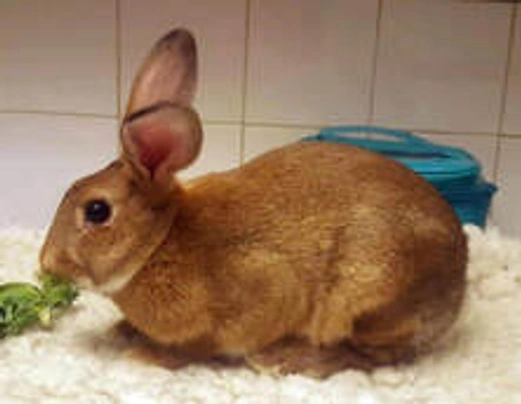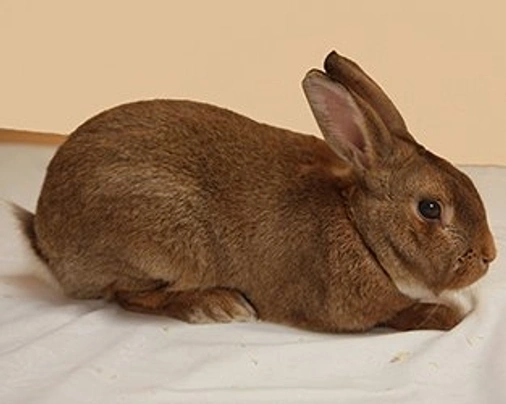Pets
Pets for studWanted petsBreedersAccessories & services
Knowledge hub
Support
Support & safety portalGolden Glavcot
Introduction of the Golden Glavcot
The Golden Glavcot is an extremely rare breed of fine-boned, red coloured rabbit that enthusiasts believe was originally developed for the fur trade. The breed became extinct, but was recreated in the 1960s minus the blue and silver variations of the type, which remain extinct.
Many fanciers do not like the Golden Glavcot or ‘GG’ as they are somewhat affectionately known, as they still resemble their wild cousins, however those that do choose to breed or keep these rabbits are rewarded by a very affectionate, sweet and placid companion.
History of the Golden Glavcot
As such a rare breed that has already been brought back from extinction once, little is known about the origins of the GG, apart from the fact that it is likely it was originally bred as a fur animal and it’s this that probably contributed to its eventual demise and extinction.
In the 60s a fancier named Mr Irons, decided to try and recreate the Golden Glavcot and did so by putting together a Brown Beveren, a Havana and another rare breed, the Brown Siberian. It took Mr Irons more than 15 years to get the recipe just right, but the first examples were eventually shown in Doncaster in 1976. During the show another fancier, Mrs Brown took an interest in the breed and decided to continue with Mr Irons’ efforts to develop the true Golden Glavcot type.
It was during Mrs Brown’s attempts that the wild rabbit was introduced to the mix. Eventually the desired type was achieved and the Golden Glavcot was established and re-introduced to the rabbit world.
Appearance of the Golden Glavcot
- Main colourways: Red roan
- Average weight: 2.3 – 2.7kg
This is a fine-boned rabbit that boasts a ‘mandolin’ shape. The ears are of a proportionate length, always held upright and are the same colour as the body. The head is a moderate size and covered with soft, fine fur. It sits at the end of a fairly short, delicate neck which is of a similar colour to the rest of the body, with a visible ticking.
The legs and feet are straight and fine and have a blueish undercolour. The rest of the Golden Glavcot’s colouring starts with a wide band of grey which graduates into the brown and each hair is tipped with a pale roan. The body is interspersed with darker brown, with a lighter shade on the neck. The chest and flanks are also a lighter shade, which melts into a lighter shade still. The tail is carried straight and is the same colour as the body, with the same undercolour as the underside of the body.
Temperament of the Golden Glavcot
As a relatively new breed, the Golden Glavcot is still displaying parts of its character, but it is renowned for being friendly and very affectionate. As long as they are allowed to get used to human company when they’re young, they will love lots of cuddles.
As with all prey animals, rabbits can be skittish and can panic if they feel uncomfortable or vulnerable. It’s vital that any rabbit is handled correctly to prevent them panicking while being held as although it’s a delicate breed, the GG is very strong and can injure itself or its handler if it struggles while being held.
Health of the Golden Glavcot
As a rare and new rabbit, health problems within the breed are still being documented and it appears to be relatively healthy. However there are some conditions and issues that can affect any rabbit and any owner should monitor their pet for these.
The teeth of rodents grow continually and can cause a number of problems if they’re allowed to overgrow. Injuries in the mouth and difficulty eating, as well as runny eyes and noses are just some of the symptoms of overgrown teeth and a vet’s advice should be sought if you suspect problems with your pet’s mouth.
No rabbit should be allowed to get overweight as he will have difficulty grooming and if his coat gets soiled he could be vulnerable to flystrike; a distressing condition where flies, attracted by dirty areas of fur, lay eggs in the rabbit’s coat. The resulting maggots can burrow under the skin and cause raw, open wounds.
All rabbits must be vaccinated against myxomatosis and Viral Haemorrhagic Disease and regularly treated for fleas, ticks and worms. Does not intended for breeding may benefit from being spayed as uterine cancer is common in rabbits.
Caring for the Golden Glavcot
Most GGs are kept as show animals and are therefore often kept in hutches in sheds. This set up means that they are allowed to get used to the elements, but are protected from the worst of the weather. It’s important that any hutch is weather and waterproof (if a shed isn’t available) and any shed is well lit and well ventilated. The hutch should also have a solid floor to prevent problems with sore hocks and lined with plenty of hardwood shavings and straw which must be removed completely at least once a week.
The GG can be kept indoors, but as a small animal care should be taken not to step on him or trap him anywhere. He can be taught to use a litter tray and as long as wires and other important items are kept out of reach and he has a cage or crate to retire to, he’ll be a happy bunny.
His diet should comprise good quality hay and pellets, as well as fibrous green leaves like kale, cabbage and dandelion. He should also have access to clean drinking water at all times.

